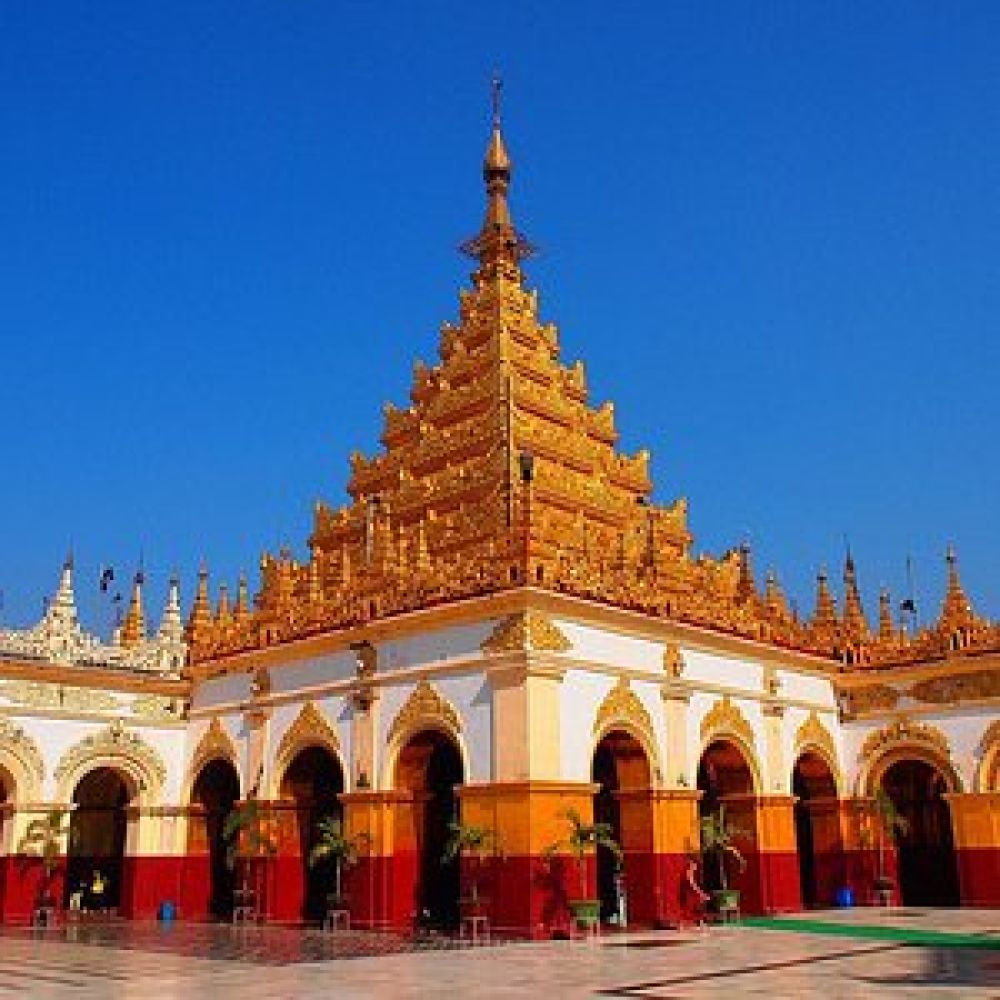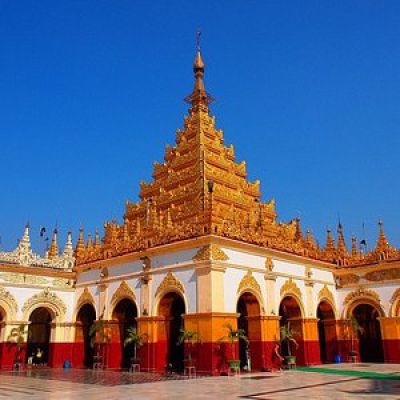

Explore the spiritual heritage of the Mahamuni Buddha Temple in Mandalay on a guided tour. This experience allows you to delve into the history and religious significance of one of Myanmar's most revered Buddhist sites. The temple is home to the Mahamuni Buddha statue, which is believed to be over 2,000 years old and is covered in gold leaf applied by devout followers. Throughout the tour, you will learn about the daily rituals, the significance of offerings, and observe the devout in prayer. Additionally, you'll walk through the temple's surrounding complex, filled with various shrines, pavilions, and a bustling market selling religious artifacts and offerings. The tour provides an in-depth look at Burmese culture and Buddhism, leaving you with a deeper understanding of the local customs and beliefs.
Participate in an ancient and ongoing tradition by applying gold leaf to the Mahamuni Buddha statue at the Mahamuni Buddha Temple. This unique activity provides an intimate spiritual experience, as you will join the ranks of countless pilgrims who have adorned the statue over centuries, contributing to its cladding of gold. Before approaching the statue, you will purchase thin squares of gold leaf from local vendors situated nearby the temple. Then, you will have the opportunity to press the gold leaf onto the Buddha's body, an act believed to bring merit and blessings in Theravada Buddhism. The experience is also a chance to witness the dedication and devotion of the local worshippers, with men applying the gold directly onto the Buddha and women doing so indirectly via an intermediate medium, adhering to traditional practices.
Capture the timeless beauty of the Mahamuni Buddha Temple with a photography session. The temple's architecture provides a stunning backdrop, with intricate carvings, golden spires, and the shimmering Mahamuni Buddha statue itself. Photographers can focus on the diverse subject matter, from the detailed craftsmanship of the temple's adornments to the daily practices of the monks and pilgrims. Whether you're a professional looking to add to your portfolio or an amateur eager to document your journey, the temple provides ample opportunities for breathtaking images. However, it's important to be respectful and seek permission when photographing individuals on the sacred grounds. Early morning or late afternoon visits are recommended for the best natural lighting conditions, and these times often coincide with fewer crowds.
Engage in a peaceful meditation session at the serene environment of the Mahamuni Buddha Temple. Situated away from the bustling streets of Mandalay, the temple offers a tranquil ambiance ideal for mindfulness and reflection. You can participate in a group meditation with local monks or find a quiet spot within the temple grounds to practice solo. The gentle sound of temple bells and the murmurs of chanting create an immersive atmosphere that promotes deep contemplation and inner peace. Visitors are encouraged to embrace the stillness and absorb the spiritual energy of this holy place. While the temple does not formally organize meditation for tourists, it's a welcoming space for those seeking to practice on their own. Remember to dress modestly and to follow the temple's etiquette during your visit.
Take part in the daily religious offerings and rituals at the Mahamuni Buddha Temple to experience the local Buddhist practices firsthand. As part of this devotional activity, you can purchase flowers, incense, candles, and other traditional offerings from nearby stalls. You'll then present these offerings at the various altars and shrines around the temple complex. This ritual is a way to show respect and reverence for the Buddha and is considered an act of merit in Buddhism. You will observe how local worshippers perform their religious duties, including paying homage to the statue, lighting candles, and reciting prayers. It's an intimate way to connect with the sacred, immerse yourself in the culture, and reflect on the importance of spirituality in the lives of Burmese Buddhists. As a participant, it's essential to approach these activities with an attitude of respect and mindfulness.
Discover a colorful array of goods at the market surrounding the Mahamuni Buddha Temple. This bustling market is an integral part of the temple experience and a lively spot for exploring local commerce. You can shop for religious artifacts, traditional Burmese crafts, textiles, jewelry, and an assortment of souvenirs to take back home. The stalls also offer a variety of local snacks and refreshments, giving you a taste of authentic Myanmar cuisine. The market visit provides a cultural immersion into the daily lives of locals and a deeper understanding of the economic activities linked to the temple. It's an excellent opportunity to practice your bargaining skills, support local artisans, and purchase unique items that reflect the artistry and traditions of Myanmar. A stroll through the temple market can be a delightful addition to your visit and a way to engage with the community.
Witness a traditional ceremony at the Mahamuni Buddha Temple to gain insights into the rich tapestry of Burmese Buddhist rituals. Throughout the year, the temple hosts various religious ceremonies and festivals, seeing an influx of pilgrims and monks participating in time-honored rites. These events often include processions, recitations of Pali scriptures, and communal offerings. Attending one of these ceremonies can be an extraordinary way to connect with the local community and experience the spiritual vibrancy of the temple. Due to the cultural and religious importance, it's crucial for visitors to demonstrate respect by dressing appropriately, behaving courteously, and observing the activities without causing disturbances. Participation in these events tends to be free of charge, but always check if there are specific guidelines or schedules for tourists.
Immerse yourself in the art and iconography that adorn the Mahamuni Buddha Temple by engaging in a learning-focused exploration. The temple complex is known for its intricate designs, symbolic decorations, and religious iconography, offering visitors a visual feast that narrates the stories and teachings of Buddhism. A local guide or art historian can explain the meanings behind various statues, frescoes, murals, and architectural elements. This activity provides an opportunity to gain a deeper appreciation of the temple's aesthetic beauty and to understand how art serves as a medium for conveying religious principles and history. Examining the temple's artwork serves not just as an art lesson but also as an introduction to the spiritual and cultural values cherished in Burmese Buddhism.
Participate in the time-honored tradition of alms giving by offering food to the monks at Mahamuni Buddha Temple early in the morning. This revered practice involves presenting monks with their daily sustenance as they walk through the temple grounds in a silent, solemn procession. As a visitor, you can experience the joy of giving by preparing small offerings of rice or simple foods. Observe the graceful exchange between laypeople and the monastic community, characterized by mutual respect and gratitude. Partaking in alms giving allows you to contribute to the upkeep of the monkhood and offers a humbling opportunity to practice generosity, a key virtue in Buddhism. It's an eye-opening cultural experience that starts the day with positive intentions and profound respect for the local way of life.
Experience the cultural heritage of Myanmar with a traditional Burmese puppet show often performed in the vicinity of the Mahamuni Buddha Temple. Puppetry in Myanmar is an art form with deep roots and is known locally as 'yoke thé'. These captivating performances feature expert puppeteers who bring to life intricate, hand-crafted puppets dressed in elaborate costumes. The shows typically depict folk tales, religious stories, or royal court scenes, often accompanied by live traditional music. Watching a puppet show can be a delightful way to unwind after a day of temple exploration and provides a glimpse into the country's performing arts legacy. It's a family-friendly activity that entertains while also preserving and showcasing an important aspect of Myanmar’s intangible cultural heritage.
